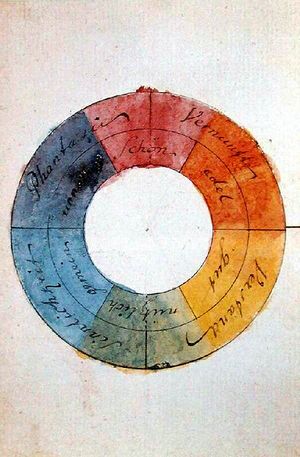Color circle


The color wheel (also called color circle) is a circular arrangement of selected hues to illustrate their mutual relationships. Since the relationships of the colors to each other are many-dimensional and complex, there are a variety of possibilities for the selection and arrangement of the different hues. One can, for example, take purely technical-physical criteria into account, or rely more on the immediate color perception of man, as Goethe, for example, did in his Theory of Colours, and thereby do justice to the artistic and spiritual aspects of color in particular. At the same time, it is noticeable that normally sighted people, even without any further knowledge about the principles of color perception, usually arrange the color tones in exactly the same sequence, whereby the beginning and the end of this color scale are so similar to each other that it can be closed into a circle without a break.
The basic principle of each color circle is based on the fact that similar, related colors are arranged close to each other, while the complementary colors are diametrically opposed to the corresponding original colors. The complementary color is the color that, when mixed with the original color, produces an achromatic, i.e. color-neutral, gray tone. The projection of the natural color variety onto a flat surface necessarily causes a strong simplification ("flattening") of the manifold color relationships. The representation on a curved surface, such as the German painter and acquaintance of Goethe Philipp Otto Runge (1777-1810) attempted with his color sphere, offers a somewhat greater scope in this respect.
In Goethe's six-part color circle, all color appearances, as they successively arise from the polarity of light and dark according to the chromatic primordial phenomena and further through mixing and enhancement, arrange themselves with the deeper spiritual experience of man into a harmonious whole. Here the spiritual breadth of Goethe's work becomes tangible. Goethe does not shy away from the allegorical, symbolic and mystical use of color:
„That finally also the color allows a mystical interpretation, can well be suspected. For since that scheme, in which the color manifoldness can be represented, indicates such primordial relations, which belong to the human view as well as to nature, there is no doubt that one can make use of its references, as it were as a language, also there, if one wants to express primordial relations, which do not fall just as powerfully and manifoldly into the senses. The mathematician appreciates the value and use of the triangle; the triangle is held in great veneration by the mystic; many things can be schematized in the triangle, and the appearance of colors likewise, in such a way that one arrives at the old mysterious hexagon through doubling and interlacing.“
And further it is said:
„When one has correctly grasped the separation of the yellow and the blue, but especially when one has sufficiently observed the increase into the red, by which the opposites incline against each other and unite in a third, then a special mysterious perception will certainly occur, that a spiritual meaning can be attributed to these two separate, mutually opposed beings, and one will hardly refrain, when one sees them produce the green below and the red above, from thinking there of the earthly, here of the heavenly spawns of the Elohim.“
Literature
- Olaf L. Müller: Mehr Licht: Goethe mit Newton im Streit um die Farben, S. Fischer Verlag, ISBN 978-3100022073, eBook ASIN B00OVFTIXU
- Rudolf Steiner: Das Wesen der Farben, GA 291 (1980) English: rsarchive.org German: pdf pdf(2) html mobi epub archive.org
- Rudolf Steiner: Farbenerkenntnis, GA 291a (1990) English: rsarchive.org German: pdf pdf(2) html mobi epub archive.org
 |
References to the work of Rudolf Steiner follow Rudolf Steiner's Collected Works (CW or GA), Rudolf Steiner Verlag, Dornach/Switzerland, unless otherwise stated.
Email: verlag@steinerverlag.com URL: www.steinerverlag.com. Index to the Complete Works of Rudolf Steiner - Aelzina Books A complete list by Volume Number and a full list of known English translations you may also find at Rudolf Steiner's Collected Works Rudolf Steiner Archive - The largest online collection of Rudolf Steiner's books, lectures and articles in English. Rudolf Steiner Audio - Recorded and Read by Dale Brunsvold steinerbooks.org - Anthroposophic Press Inc. (USA) Rudolf Steiner Handbook - Christian Karl's proven standard work for orientation in Rudolf Steiner's Collected Works for free download as PDF. |
